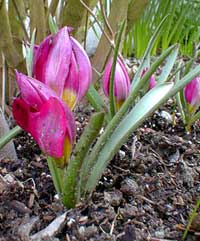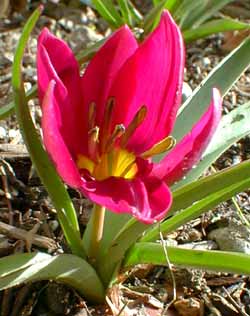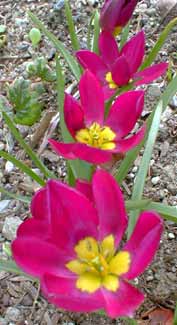 'Violacea'
'Violacea'
Crocus Tulip, strain #2
"As the tulip shrinks from the cold night air
So shrank my heart, & quailed in the shade."
-Hafiz,
translated by Gertrude Bell
translated by Gertrude Bell
We obtained 'Violacea' crocus tulips from two sources in different years, planting them in different locations. The two strains are so distinct from one another it is almost impossible to believe they are the same species variant rather than separate cultivars. Those shown on this page we've assigned the designation 'Strain #2,' & they were obtained under the incomplete name of Tulipa violacea.
 Its specific taxonomic name is T. humilis var. violacea, synonymous with the now rejected T. pulchella var. violacea, although some bulb-importers still put this outdated name on packaging or in catalogs.
Its specific taxonomic name is T. humilis var. violacea, synonymous with the now rejected T. pulchella var. violacea, although some bulb-importers still put this outdated name on packaging or in catalogs.The first March photo shows 'Violacea' with petals closed on an overcast days. The second photo shows the open flower. The third photo later in March shows the lovely star-shaped yellow interiors. All the photos convey accurately how close to the ground it blooms.
 There's a separate page for T. humilis 'Violacea,' strain #1 which starts blooming for us quite a bit earlier. 'Violacea #1' begins blooming in February (by a long shot the earliest of our botanical tulips) but can be easily damaged by elements & worn out in only two weeks, whereas 'Violacea #2' begins flowering by the second week in March & lasts well into April, a full three & possibly four weeks.
There's a separate page for T. humilis 'Violacea,' strain #1 which starts blooming for us quite a bit earlier. 'Violacea #1' begins blooming in February (by a long shot the earliest of our botanical tulips) but can be easily damaged by elements & worn out in only two weeks, whereas 'Violacea #2' begins flowering by the second week in March & lasts well into April, a full three & possibly four weeks.'Violacea #2' has thinnish purple-pink petals which unfold wide on sunny days revealing yellow heart & yellow anthers; 'Violacea #1' has fatter petals that form bigger fuchsia-pink globes that do not open very far, remaining fat balls for their duration.
In further contrasts, 'Violacea #2' is only three or at most four inches tall; 'Violacea #1' is four or five inches tall. 'Violacea #2' is the more delicate-looking & refined of the two but blooms a full four weeks; 'Violacea #1' looks tougher but wears out within three weeks. And finally, 'Violacea #1' produces a bright pink bud simultaneous with its leaf appearance late in February, but 'Violacea #2' which blooms later than #1 nevertheless sends up thinner leaves earlier, poking the tips of its leaves out of the ground so early as the last week of January.
We've a third, cloned violacea strain which is marketed as 'Persian Pearl.' It reaches six or eight inches of height, is a deeper magenta petal with light silvering on the the outside of the outermost petals, & waits until the tail-end of March to start blooming.
So all three are very distinct, though only 'Persian Pearl' has been given a distinct name in the nursery trade.
 The species has been known in Europe, according to Sir Alfred Daniel Hall in The Genus Tulip (1940) since the early 1800s. But it was not formally described until 1844, when it was recorded by the Dean of Manchester, William Herbert (1778-1847).
The species has been known in Europe, according to Sir Alfred Daniel Hall in The Genus Tulip (1940) since the early 1800s. But it was not formally described until 1844, when it was recorded by the Dean of Manchester, William Herbert (1778-1847).The variant was first described in 1858 by Swiss botanist, explorer & mathematician Pierre Edmond Boissier (1810-1885), in a tract on Persian flora translated into English in 1860. A portrait of this Nineteenth Century plant explorer is shown at the right.
This is one of the shortest of all botanical tulips, which trait the species name humilis refers to. An alpine tulip suitable to zones 3 through 8, it enjoys full sun to partial sun. In the Pacific Northwest it likes a sheltered location, as our moderate weather is actually "warm" for it.
'Violacea' of any strain ought to naturalize with ease, becoming a thicker drift of tulips after a very few years. The strain we've designated #2 grows near the crown of a Western Syringa (Philadelphius lewisii), where it gets afternoon sunlight in spring, for it is active so early that the Western Syringa has not yet regained its leaves & does not shade the ground in that area, as also a nearby cherry tree.
But when this small drift's flowers are spent & only the leaves remain, I've worried that the shade from the by-then releafing shrubs may be deep enough that the bulbs won't properly recharge & naturalize, so I may someday end up lifting them for a spot that gets more sun. They've bloomed fine for two years running, however, so as of spring 2004, I've not yet felt they should be moved to a brighter location.